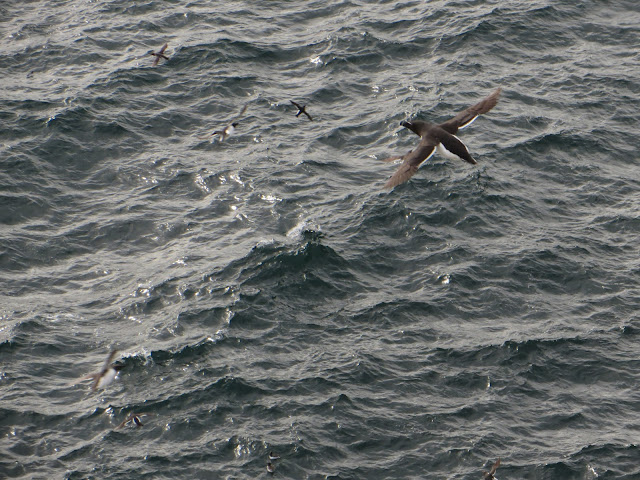Saturday 15th June 2013
Our final day. We had nearly until 4 on the island so treated it as normal until lunch then two hours to tidy and pack (thank you Keith, Hallgeir, James, Tim, Ruth!)
In the traps, 6.30-7am we caught a young rock pipit. These birds are all over the island; the phrase is 'lbj' (little brown job); they're often overlooked, like the dunnocks that are likely in your garden and on all of your walks. Every bird is intricate in plumage when seen really close-up. The pipit we caught was born this year, signs of its yellow fleshy 'gape' still showed where beak joins head.
I didn't paint today, just drawing: puffins at various spots and then the Arctic terns for an hour before the two tourist boats arrived. I hadn't yet drawn the terns and found them really difficult. They're very slender, with wings like sharp white rapiers. They twist and turn balletically in flight and their tails form a wide fan when they land or hover. The overall look is white, with a black skull-cap and a bright scarlet dagger bill that matches remarkably small scarlet feet. In time will evolution remove their feet completely? ("Not unless they never want to land or swim again!", points out Jennifer, sensibly.)
Arctic tern preening postures
The puffins on the island are interesting. Those seen are mostly juveniles, birds that are only a year or two (or three or four) old; they don't become sexually mature until they're 4 or 5. The ones that can't yet breed instead stand around on every available rock and roof and slope and wall. A few will be holding sand eels and small fish in their beaks in an attempt at impressing prospective partners. Puffins generally mate for life and ringing records show typical lifespan to be 18 years. The oldest known bird was recorded as 35 years, 11 months, 13 days, in 2010 - BTO puffin ringing recoveries.
The puffin in the middle has its eye closed, yet the eye ring and leathery eye patch makes you think it might be open but squinting. In winter these adornments are shed completely, along with the puckered yellow 'lip' and part of the beak.
Breeding puffins will rarely be seen - they're either off fishing or are down in their burrows. Parent puffins fly in from the sea, food in beak, either flying directly into their burrow or landing immediately outside it and scampering in – to avoid gull predation. The burrows are often old rabbit holes, which the island is covered in.
I at last found time for a sketch inside the South Horn. I love it in there, perhaps my favourite place on the island. It's peaceful and quiet; the sounds of outside are deadened. Through a bendy-glassed window cut in the thick stone walls is a distorted view of rocks and sea and the East Lothian coast (weather dependent of course!) I hope to paint this same window scene one day in acrylics.
Leaving:
At quarter to four we were loaded up on the boat, sad but content after such a productive week. Luggage was well wrapped and tarpaulined to protect sketches. At the Kirk Haven harbour entrance were two turnstones on the rocks and on my final circuit of the island I'd seen three starlings - 2 new bird species for my stay, bringing me to...
a total of 34 bird species seen throughout the week.
The sea was choppy and the RIB Osprey bounced us up and down but luckily didn't make me feel more than just a little queasy. Salt water spray covered our faces and lips but my clothes were well waterproofed. It was almost fun.
Lifts were given to Leuchars thanks to Tim and Ruth, and Keith, then the train to Edinburgh for me and James and Hallgeir. Then we went our separate ways.
A bath was nice.
New birds today:
starling
turnstone
a razorbill composition, to be painted
Island oddities:
On the Isle of May you often see humans doing strange things; necks strung with cameras, lenses as long as your arm, large rucksack containing more. You see a lot of people doing this:
photo thanks to Silvana Grimaldi
And, when I was there, at least one doing this (look at the feet):
photo thanks to Silvana Grimaldi
I like walking barefoot. It feels natural and fresh and 'real', brings an extra dimension to being outdoors. And of course there are no dogs on the island. On one of the hotter days my shoes were off whilst painting so I decided to keep them off for my walk back to the Low Light. Over a kilometre of upslope, downslope; grass, earth, concrete, gravel. Gravel can jag but go slow and its fine. Grass is the best of all, walk barefoot over your lawn at home and you'll see what I mean.

.JPG)
.JPG)













.jpg)
.jpg)

.JPG)
.jpg)


.jpg)
.jpg)
.jpg)
.jpg)
.jpg)










